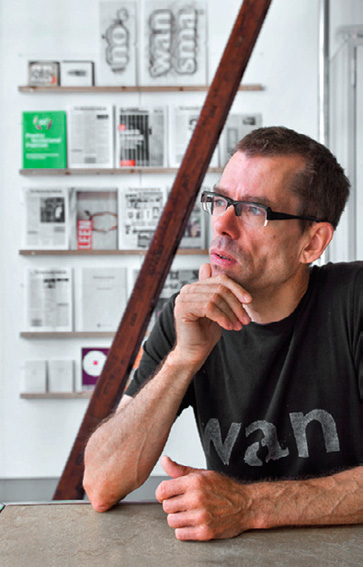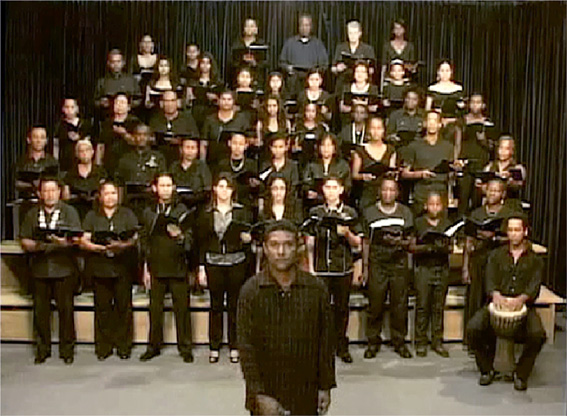

Arnold Schalks in his Rotterdam studio (photo: Otto Snoek)
At the start of the Eighties, Arnold Schalks (Leiden, 1956) was the drummer in a punk band called Defect. He takes an LP called Spunk from the shelf, containing a collection of tracks by Rotterdam bands, including one by Defect, plus a photo of a short-haired Schalks in Defect. “I always really liked drumming, because I like playing the facilitating roles,” he says. “So I wouldn’t want to be the lead, but part of a complex in the background, providing the carpet you can wipe your feet clean on.”
He now sings in a choir. But that supporting role of the drummer and the direct and idiosyncratic approach of punk has remained. A fascination for language has been added too. That is the packaging for his skittish, conceptual art projects. “I’ve always tried to tie different disciplines in with each other – the performing side with the literary or the visual.”
In practice, that means that Schalks goes to a place and tries to find its characteristic features, which are often caricatures. “I enlarge those and work with them.” For instance, he took a walk of 4711 steps to sprinkle a notorious spot that people used as an outdoor toilet with a mixture of eau de cologne, tap water and urine. The project was entitled Colonia non olet – ‘Cologne doesn’t stink’.
He was then asked for ArtRoPa, visited Suriname, walked around Paramaribo until he could barely stand, and bought books. Piles of books. As he did so, he became fascinated by the long tradition of Surinamese poetry, which is largely unknown in the Netherlands. The one who impressed him above all was Shrinivási (real name Martinus Lutchman, born in 1926). He stands up again and comes back with a collection by the poet. “Here, try this: Immigration. Great, isn’t it? This man is Surinamese. He grew up there, and moved to the Antilles later. There’s nowhere he calls home now. A pariah in his own country, in fact.”
It was then that Schalks set up his own gigantic poetry database, his prakseri bangi or ideas bank, with over five hundred Surinamese poems. Together with the Surinamese artists Kurt Nahar and Steve Ammersingh, he wanted to distil a ‘national lyric of unity’ from it, expressing Surinamese diversity. “My idea was that Suriname is a patchwork of ethnicity, and each group of the population has its own poetry. I wanted to cut all those things up and reassemble them, you know, combining a line by a Hindustani poet with a line by a Javanese. I wanted to present it on Independence Day 2008, but it never got off the ground…”
The idea of a poetry of unity remained, though, but Schalks reduced it to a single existing poem, Wan by Dobru. “It’s simple, very clear, and preaches a kind of unity: we’re all separate leaves on a tree, but there’s a single trunk: Suriname. That’s a false kind of unity, actually, because it’s not there in reality. So the poem is more like a daydream. I didn’t want to use it politically, but in a human and conceptual way. A poem that tries to find unity in diversity.” Schalks’ aim was to have the poem translated into all the Surinamese languages, and work from there. In the end he got seventeen translations, including Trío and Lebanese. But form alone was not enough. It needed imagery too, a performance. Three representatives from each language – a man, woman and child, a bass, baritone and soprano – had to come on stage together to perform Wan.
Arnold Schalks with the Someni Tongo choir in the Palm Garden, Paramaribo, Saturday, 29 November 2008, 11:00 h. local time (photo: Kit Ling Tjon Pian Gi )
Carrying out the project exposed an important element of Suriname for him: mutual distrust. “You can see that people are very reserved about performing together, and that certain groups of the population normally don’t interact with one another.” Even so, he managed to get sixteen language groups interested in the project in the end. Half a dozen rehearsals preceded the big day. At midday on 22 November 2008, the choir of over forty people performed in the Surinamese television studio. Schalks had split the poem into five pieces. Some parts and stanzas were sung by everyone in Sranantongo, but other parts were in their own languages. The poem rose and fell, moving back and forth between monolingual harmony and multilingual cacophony.
He shows the video images taken just after it had finished, with the performers falling into each others’ arms, clearly moved. “At a certain moment, it gets to everyone. Not because of the tension, but genuinely because they were so pleased that they had all done this together. Dobru’s widow, Mrs Ravales, said the Dobru must surely have been smiling down from heaven.”

Videostill of the Someni tongo-recitation that was broadcasted live from the STVS-studio in Paramaribo on 22 November 2008 at 12:00 h.
The same idea underpins Schalks’ newspaper initiative de Surinoemer. Together with artists from Rotterdam and Suriname, he made a trip to Kosindo in the interior. The idea was to do a bit of brainstorming about ArtRoPa, but that never really got going. Schalks’ solution for greater cohesion was a newspaper. Since December 2007, seven editions of de Surinoemer have appeared, in a print run of about 250, printed in A4 format. The aim is to inform the Dutch and Surinamese about the content and progress of the ArtRoPa project. Issue 4 had a Dadaist cover, a landscape format and contained lino-cuts and poems by Schalks, Nahar and Marieke Visser among others, as well as the Rotterdam icon C.B. Vaandrager, who had died in 1992.
It was essential for Schalks that people from Suriname were directly involved in his projects. “Suriname deserves closer cooperation. It is a country with loads of possibilities, but a huge amount of confusion about recent history, the regime, and so on. They’ve got to get that cleared up. Ethnicity is a hot potato, even in art. “Our forefathers dumped people there who do not naturally belong together in any way at all. They stitched it all together like a patchwork, but the grafts never took and grew to become one. And the politicians were able to benefit by emphasising ethnicity and cultivating those differences.”
‘I’m fascinated by Surinamese
poetry, which is largely unknown
in the Netherlands’Schalks’ opinion is that people must find a way to function within the melting-pot that is Suriname. “But before that, you’ve got to get to the heart of what [being Surinamese] means. That’s happening. And it’s important: you can only give if you know what you have that can be given away.”
Arnold Schalks in his Surinamese Office, Celinastraat 9, Paramaribo, 7 October 2008.
With a sigh of mild disappointment, he continues, “Look: you mobilise people, but what you come up against time and again is that it’s always in the short term. Things just don’t get moving.” He fetches Shrinivási again. “He was making the case very early on for cohesion within that ethnic patchwork.” He gets me to read aloud: I would like to bind you / into a single nation / A reality, not just a fairy tale / Because our words are Surinamese / yet we remain negro, Hindustani, Javanese or Chinese.
Fred de Vries, Rotterdam, 31 July 2009
(translated from the Dutch by Mike & Clare Wilkinson/Ruud Faulhaber)
Stage in the Rotterdam studio.